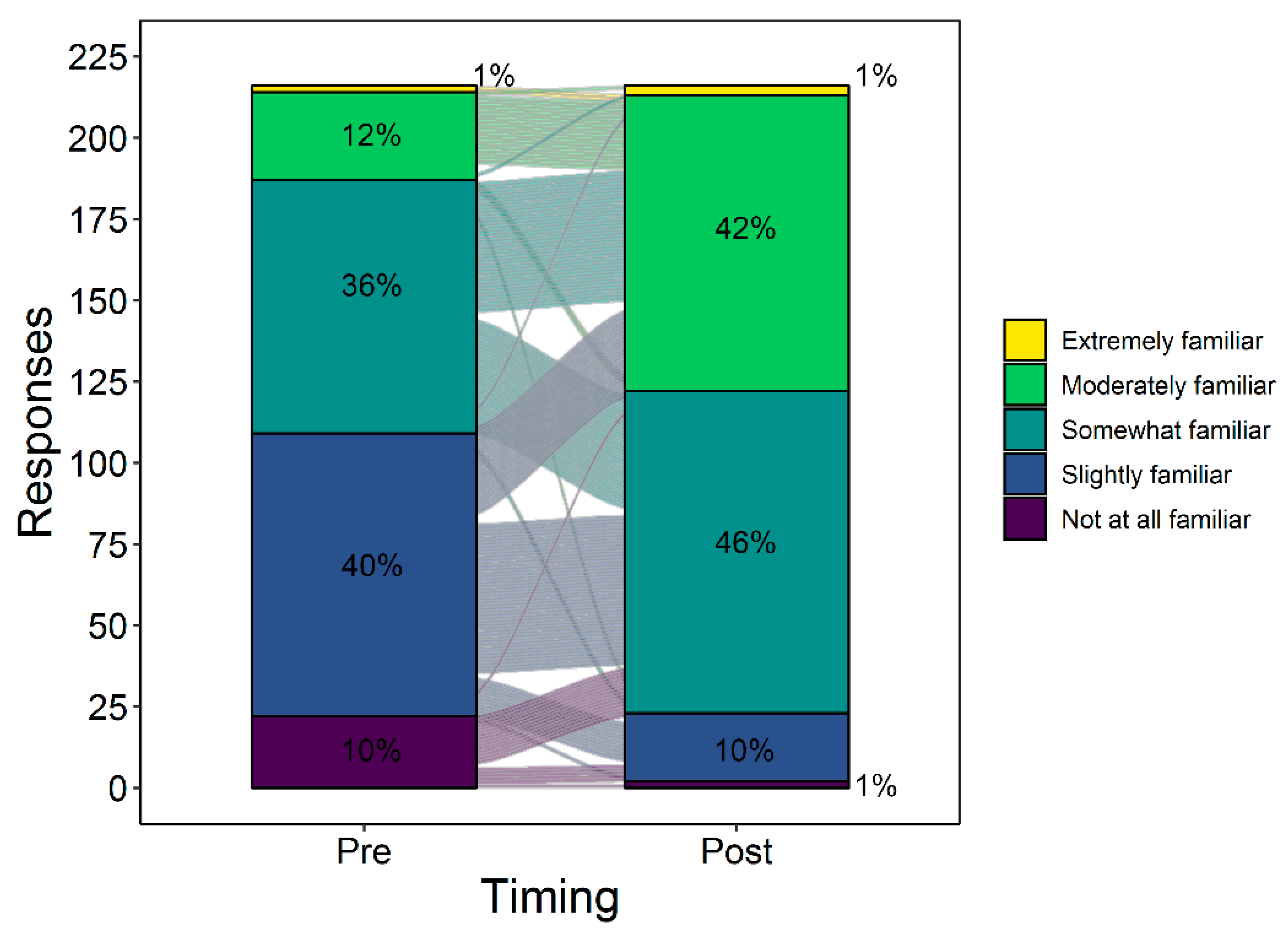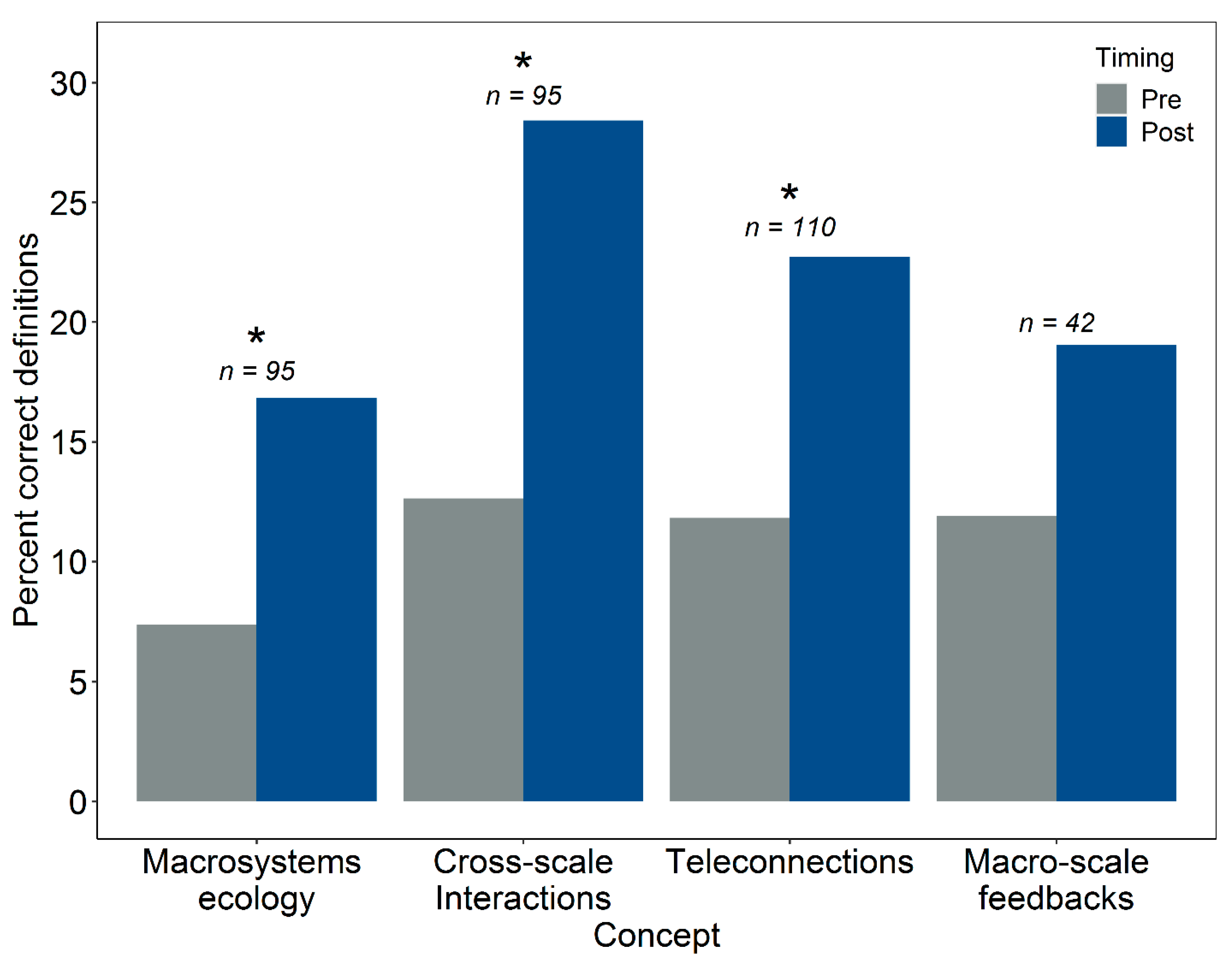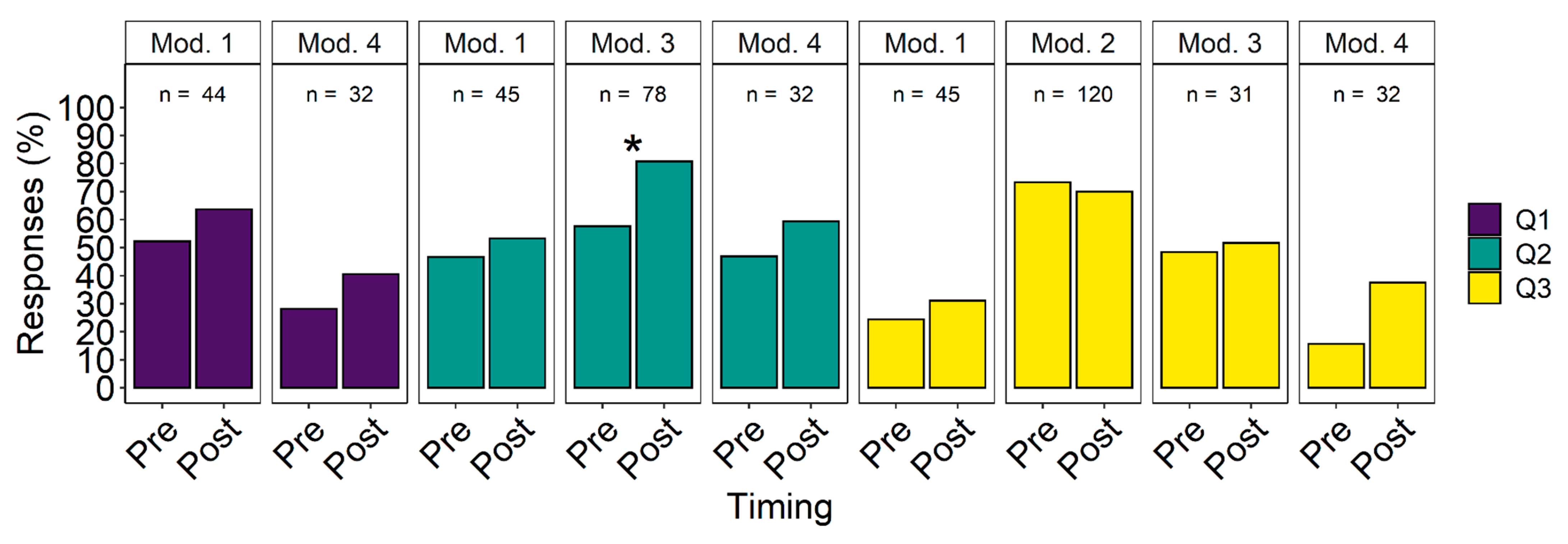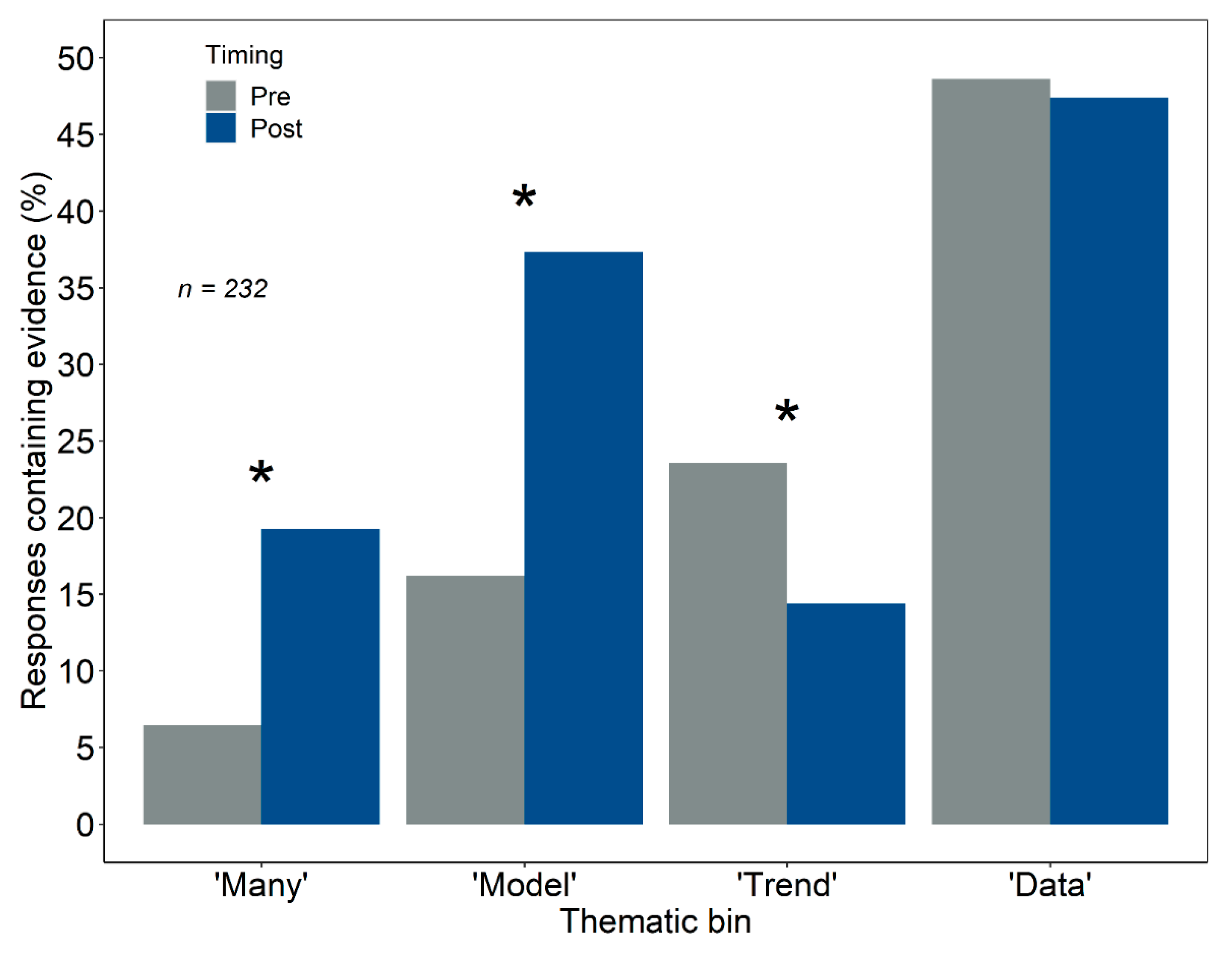Macrosystems EDDIE Teaching Modules Increase Students’ Ability to Define, Interpret, and Apply Concepts in Macrosystems Ecology
Abstract
:1. Introduction
2. Materials and Methods
2.1. Macrosystems EDDIE Modules
2.2. Module Implementation and Assessment
3. Results
3.1. Increased Familiarity with Macrosystems Ecology and Greater Confidence Using Data
3.2. Hypothesis-Driven, Hands-On Activities Promote Macrosystems Ecology Learning
4. Discussion
Module Limitations and Potential Improvements
5. Conclusions
Supplementary Materials
Author Contributions
Funding
Institutional Review Board Statement
Informed Consent Statement
Data Availability Statement
Acknowledgments
Conflicts of Interest
Appendix A
Appendix A.1. Assessment Description
Appendix A.2. Student Assessment Analysis
References
- Heffernan, J.B.; Soranno, P.A.; Angilletta, M.J.; Buckley, L.B.; Gruner, D.S.; Keitt, T.H.; Kellner, J.R.; Kominoski, J.S.; Rocha, A.V.; Xiao, J.; et al. Macrosystems ecology: Understanding ecological patterns and processes at continental scales. Front. Ecol. Environ. 2014, 12, 5–14. [Google Scholar] [CrossRef] [Green Version]
- Fei, S.; Guo, Q.; Potter, K. Macrosystems ecology: Novel methods and new understanding of multi-scale patterns and processes. Landsc. Ecol. 2016, 31, 1–6. [Google Scholar] [CrossRef] [Green Version]
- Dahlin, K.M.; Ault, T.R. Global linkages between teleconnection patterns and the terrestrial biosphere. Int. J. Appl. Earth Obs. Geoinf. 2018, 69, 56–63. [Google Scholar] [CrossRef]
- Zarnetske, P.L.; Read, Q.D.; Record, S.; Gaddis, K.D.; Pau, S.; Hobi, M.L.; Malone, S.L.; Costanza, J.M.; Dahlin, K.; Latimer, A.M.; et al. Towards connecting biodiversity and geodiversity across scales with satellite remote sensing. Glob. Ecol. Biogeogr. 2019, 28, 548–556. [Google Scholar] [CrossRef] [PubMed] [Green Version]
- Soranno, P.A.; Wagner, T.; Collins, S.M.; Lapierre, J.; Lottig, N.R.; Oliver, S.K. Spatial and temporal variation of ecosystem properties at macroscales. Ecol. Lett. 2019, 22, 1587–1598. [Google Scholar] [CrossRef]
- Farrell, K.J.; Weathers, K.C.; Sparks, S.H.; Brentrup, J.A.; Carey, C.C.; Dietz, M.C.; Foster, J.R.; Grayson, K.L.; Matthes, J.H.; SanClements, M.D. Training macrosystems scientists requires both interpersonal and technical skills. Front. Ecol. Environ. 2021, 19, 39–46. [Google Scholar] [CrossRef]
- Weathers, K.C.; Groffman, P.M.; Van Dolah, E.; Bernhardt, E.; Grimm, N.B.; McMahon, K.; Schimel, J.; Paolisso, M.; Maranger, R.; Baer, S.; et al. Frontiers in Ecosystem Ecology from a Community Perspective: The Future is Boundless and Bright. Ecosystems 2016, 19, 753–770. [Google Scholar] [CrossRef] [Green Version]
- O’Reilly, C.M.; Gougis, R.D.; Klug, J.L.; Carey, C.C.; Richardson, D.C.; Bader, N.E.; Soule, D.C.; Castendyk, D.; Meixner, T.; Stomberg, J.; et al. Using Large Data Sets for Open-Ended Inquiry in Undergraduate Science Classrooms. BioScience 2017, 67, 1052–1061. [Google Scholar] [CrossRef] [Green Version]
- Soranno, P.A.; Cheruvelil, K.S.; Bissell, E.G.; Bremigan, M.T.; Downing, J.A.; Fergus, C.E.; Filstrup, C.T.; Henry, E.N.; Lottig, N.R.; Stanley, E.H.; et al. Cross-scale interactions: Quantifying multi-scaled cause–effect relationships in macrosystems. Front. Ecol. Environ. 2014, 12, 65–73. [Google Scholar] [CrossRef] [Green Version]
- Kitzberger, T.; Brown, P.M.; Heyerdahl, E.K.; Swetnam, T.W.; Veblen, T.T. Contingent Pacific-Atlantic Ocean influence on multicentury wildfire synchrony over western North America. Proc. Natl. Acad. Sci. USA 2007, 104, 543–548. [Google Scholar] [CrossRef] [Green Version]
- Solomon, C.T.; Bruesewitz, D.A.; Richardson, D.C.; Rose, K.C.; Van de Bogert, M.C.; Hanson, P.C.; Kratz, T.K.; Larget, B.; Adrian, R.; Babin, B.L.; et al. Ecosystem respiration: Drivers of daily variability and background respiration in lakes around the globe. Limnol. Oceanogr. 2013, 58, 849–866. [Google Scholar] [CrossRef] [Green Version]
- Keenan, T.F.; Migliavacca, M.; Papale, D.; Baldocchi, D.; Reichstein, M.; Torn, M.; Wutzler, T. Widespread inhibition of daytime ecosystem respiration. Nat. Ecol. Evol. 2019, 3, 407–415. [Google Scholar] [CrossRef]
- NRC. NEON: Addressing the Nation’s Environmental Challenges; The National Academies Press: Washington, DC, USA, 2004. [Google Scholar]
- Weathers, K.C.; Hanson, P.C.; Arzberger, P.; Brentrup, J.; Brookes, J.; Carey, C.C.; Gaiser, E.; Gaiser, E.; Hamilton, D.P.; Hong, G.S.; et al. The Global Lake Ecological Observatory Network (GLEON): The evolution of grassroots network science. Limnol. Oceanogr. Bull. 2013, 22, 71–73. [Google Scholar] [CrossRef]
- Hanson, P.C.; Weathers, K.C.; Kratz, T.K. Networked lake science: How the Global Lake Ecological Observatory Network (GLEON) works to understand, predict, and communicate lake ecosystem response to global change. Inland Waters 2016, 6, 543–554. [Google Scholar] [CrossRef]
- Li, D.; Stucky, B.J.; Deck, J.; Baiser, B.; Guralnick, R.P. The effect of urbanization on plant phenology depends on regional temperature. Nat. Ecol. Evol. 2019, 3, 1661–1667. [Google Scholar] [CrossRef]
- Marcé, R.; George, G.; Buscarinu, P.; Deidda, M.; Dunalska, J.; de Eyto, E.; Flaim, G.; Grossart, H.-P.; Istvanovics, V.; Lenhardt, M.; et al. Automatic High Frequency Monitoring for Improved Lake and Reservoir Management. Environ. Sci. Technol. 2016, 50, 10780–10794. [Google Scholar] [CrossRef] [PubMed]
- Weintraub, S.R.; Flores, A.N.; Wieder, W.R.; Sihi, D.; Cagnarini, C.; Gonçalves, D.R.P.; Young, M.H.; Li, L.; Olshansky, Y.; Baatz, R.; et al. Leveraging Environmental Research and Observation Networks to Advance Soil Carbon Science. J. Geophys. Res. Biogeosci. 2019, 124, 1047–1055. [Google Scholar] [CrossRef] [Green Version]
- Seyednasrollah, B.; Young, A.M.; Li, X.; Milliman, T.; Ault, T.; Frolking, S.; Friedl, M.; Richardson, A.D. Sensitivity of Deciduous Forest Phenology to Environmental Drivers: Implications for Climate Change Impacts Across North America. Geophys. Res. Lett. 2020, 47. [Google Scholar] [CrossRef]
- Becknell, J.M.; Desai, A.R.; Dietze, M.C.; Schultz, C.A.; Starr, G.; Duffy, P.A.; Franklin, J.F.; Pourmokhtarian, A.; Hall, J.; Stoy, P.C.; et al. Assessing Interactions Among Changing Climate, Management, and Disturbance in Forests: A Macrosystems Approach. BioScience 2015, 65, 263–274. [Google Scholar] [CrossRef] [Green Version]
- Hipsey, M.R.; Bruce, L.C.; Boon, C.; Busch, B.; Carey, C.C.; Hamilton, D.P.; Hanson, P.C.; Read, J.S.; de Sousa, E.; Weber, M.; et al. A General Lake Model (GLM 3.0) for linking with high-frequency sensor data from the Global Lake Ecological Observatory Network (GLEON). Geosci. Model. Dev. 2019, 12, 473–523. [Google Scholar] [CrossRef] [Green Version]
- Thomas, R.Q.; Brooks, E.B.; Jersild, A.L.; Ward, E.J.; Wynne, R.H.; Albaugh, T.J.; Dinon-Aldridge, H.; Burkhart, H.E.; Domec, J.-C.; Fox, T.R.; et al. Leveraging 35 years of Pinus taeda research in the southeastern US to constrain forest carbon cycle predictions: Regional data assimilation using ecosystem experiments. Biogeosciences 2017, 14, 3525–3547. [Google Scholar] [CrossRef] [Green Version]
- Cuddington, K.; Fortin, M.J.; Gerber, L.R.; Hastings, A.; Liebhold, A.; O’Connor, M.; Ray, C. Process-based models are required to manage ecological systems in a changing world. Ecosphere 2013, 4, 1–12. [Google Scholar] [CrossRef]
- Lauenroth, W.K.; Canham, C.D.; Kinzig, A.P.; Poiani, K.A.; Kemp, W.M.; Running, S.W. Simulation Modeling in Ecosystem Science. In Successes, Limitations, and Frontiers in Ecosystem Science; Pace, M.L., Groffman, P.M., Eds.; Springer: New York, NY, USA, 1998. [Google Scholar]
- Hampton, S.E.; Jones, M.B.; Wasser, L.A.; Schildhauer, M.P.; Supp, S.R.; Brun, J.; Hernandez, R.R.; Boettiger, C.; Collins, S.L.; Gross, L.J.; et al. Skills and Knowledge for Data-Intensive Environmental Research. BioScience 2017, 67, 546–557. [Google Scholar] [CrossRef] [PubMed] [Green Version]
- Cheek, K.A.; LaDue, N.D.; Shipley, T.F. Learning About Spatial and Temporal Scale: Current Research, Psychological Processes, and Classroom Implications. J. Geosci. Educ. 2017, 65, 455–472. [Google Scholar] [CrossRef] [Green Version]
- Michener, W.K.; Jones, M.B. Ecoinformatics: Supporting ecology as a data-intensive science. Trends Ecol.Evol. 2012, 27, 85–93. [Google Scholar] [CrossRef] [Green Version]
- Styers, D.M.; Schafer, J.L.; Kolozsvary, M.B.; Brubaker, K.M.; Scanga, S.E.; Anderson, L.J.; Mitchell, J.J.; Barnett, D. Developing a flexible learning activity on biodiversity and spatial scale concepts using open-access vegetation datasets from the National Ecological Observatory Network. Ecol. Evol. 2021, 11, 3660–3671. [Google Scholar] [CrossRef]
- Turner, M.G.; Gardner, R.H. Landscape Ecology in Theory and Practice: Pattern and Process; Springer: New York, NY, USA, 2015. [Google Scholar]
- Schneider, D.C. The Rise of the Concept of Scale in Ecology. BioScience 2001, 51, 545. [Google Scholar] [CrossRef] [Green Version]
- Balch, J.K.; Nagy, R.C.; Halpern, B.S. NEON is seeding the next revolution in ecology. Front. Ecol. Environ. 2020, 18, 3. [Google Scholar] [CrossRef] [Green Version]
- IPCC. Climate Change 2014: Mitigation of Climate Change. Contribution of Working Group III to the Fifth Assessment Report of the Intergovernmental Panel on Climate Change; Edenhofer, O., Ed.; Cambridge University Press: Cambridge, UK; New York, NY, USA, 2014. [Google Scholar]
- Cheruvelil, K.S.; Soranno, P.A. Data-Intensive Ecological Research Is Catalyzed by Open Science and Team Science. BioScience 2018, 68, 813–822. [Google Scholar] [CrossRef]
- Farley, S.S.; Dawson, A.; Goring, S.J.; Williams, J.W. Situating Ecology as a Big-Data Science: Current Advances, Challenges, and Solutions. BioScience 2018, 68, 563–576. [Google Scholar] [CrossRef] [Green Version]
- Carey, C.C.; Farrell, K.J.; Hounshell, A.G.; O’Connell, K. Macrosystems EDDIE teaching modules significantly increase ecology students’ proficiency and confidence working with ecosystem models and use of systems thinking. Ecol. Evol. 2020, 10, 12515–12527. [Google Scholar] [CrossRef]
- Farrell, K.J.; Carey, C.C. Power, pitfalls, and potential for integrating computational literacy into undergraduate ecology courses. Ecol. Evol. 2018, 8, 7744–7751. [Google Scholar] [CrossRef] [PubMed] [Green Version]
- Anderson, L.W.; Krathwohl, D.R. (Eds.) A Taxonomy for Learning, Teaching, and Assessing: A Revision of Bloom’s Taxonomy of Educational Objectives; Longman: New York, NY, USA, 2001. [Google Scholar]
- Biggs, J.B.; Collis, K.F. Evaluating the Quality of Leaning: The SOLO Taxonomy (Structure of the Observed Learning Outcome); Academic Press: New York, NY, USA, 1982. [Google Scholar]
- Fink, D.L. Creating Significant Learning Experiences: An Integrated Approach to Designing College Courses, 2nd ed.; John Wiley & Sons Inc.: San Francisco, CA, USA, 2007. [Google Scholar]
- Marzano, R.J.; Kendall, J.S. The New Taxonomy of Educational Objectives, 2nd ed.; Corwin Press: Thousand Oaks, CA, USA, 2007. [Google Scholar]
- Klemow, K.; Berkowitz, A.; Cid, C.; Middendorf, G. Improving ecological education through a four-dimensional framework. Front. Ecol. Environ. 2019, 17, 71. [Google Scholar] [CrossRef] [Green Version]
- Bybee, R.W.; Taylor, J.A.; Gardner, A.; Van Scotter, P.; Powell, J.C.; Westbrook, A.; Landes, N. The BSCS 5E Instructional Model: Origins and Effectiveness; A Report Prepared for the Office of Science Education and National Institutes of Health; BSCS: Colorado Springs, CO, USA, 2006. [Google Scholar]
- Gilbert, J.K.; Justí, R. Modeling-Based Teaching in Science Education; Springer: Cham, Switzerland, 2016. [Google Scholar]
- Carey, C.C.; Aditya, S.; Subratie, K.; Figueiredo, R.J.; Farrell, K.J. Macrosystems EDDIE Module 1: Climate change effects on lake temperatures. Environ. Data Initiat. 2018. [Google Scholar] [CrossRef]
- Carey, C.C.; Farrell, K.J. Macrosystems EDDIE Module 2: Cross-scale interactions. Environ. Data Initiat. 2019. [Google Scholar] [CrossRef]
- Farrell, K.J.; Carey, C.C. Macrosystems EDDIE Module 3: Teleconnections ver 4. Environ. Data Initiat. 2019. [Google Scholar] [CrossRef]
- Carey, C.C.; Farrell, K.J.; Hounshell, A.G. Macrosystems EDDIE Module 4: Macro-Scale Feedbacks ver 1. Environ. Data Initiat. 2020. [Google Scholar] [CrossRef]
- Miles, M.B.; Huberman, A.M.; Saldana, J. Qualitative Data Analysis: A Methods Sourcebook, 4th ed.; SAGE Publications Inc.: Thousand Oaks, CA, USA, 2020. [Google Scholar]
- Vogt, W.P. Dictionary of Statistics & Methodology: A Nontechnical Guide for the Social Sciences, 3rd ed.; SAGE Publications Inc.: Thousand Oaks, CA, USA, 2005. [Google Scholar]
- Terwee, C.B.; Bot, S.D.; De Boer, M.R.; Van Der Windt, D.A.; Knol, D.L.; Dekker, J.; Bouter, L.M.; De Vet, H.C. Quality criteria were proposed for measurement properties of health status questionnaires. J. Clin. Epidemiol. 2007, 60, 34–42. [Google Scholar] [CrossRef] [Green Version]
- Carey, C.C.; Gougis, R.D. Simulation Modeling of Lakes in Undergraduate and Graduate Classrooms Increases Comprehension of Climate Change Concepts and Experience with Computational Tools. J. Sci. Educ. Technol. 2017, 26, 1–11. [Google Scholar] [CrossRef] [Green Version]
- Freeman, S.; Eddy, S.L.; McDonough, M.; Smith, M.K.; Okoroafor, N.; Jordt, H.; Wenderoth, M.P. Active learning increases student performance in science, engineering, and mathematics. Proc. Natl. Acad. Sci. USA 2014, 111, 8410–8415. [Google Scholar] [CrossRef] [Green Version]
- Haak, D.C.; HilleRisLambers, J.; Pitre, E.; Freeman, S. Increased Structure and Active Learning Reduce the Achievement Gap in Introductory Biology. Science 2011, 332, 1213–1216. [Google Scholar] [CrossRef] [PubMed]
- Ballen, C.J.; Wieman, C.; Salehi, S.; Searle, J.B.; Zamudio, K.R. Enhancing Diversity in Undergraduate Science: Self-Efficacy Drives Performance Gains with Active Learning. CBE-Life Sci. Educ. 2017, 16, 1–6. [Google Scholar] [CrossRef] [PubMed]
- Theobald, E.J.; Hill, M.J.; Tran, E.; Agrawal, S.; Arroyo, E.N.; Behling, S.; Chambwe, N.; Cintrón, D.L.; Cooper, J.D.; Dunster, G.; et al. Active learning narrows achievement gaps for underrepresented students in undergraduate science, technology, engineering, and math. Proc. Natl. Acad. Sci. USA 2020, 117, 6476–6483. [Google Scholar] [CrossRef] [Green Version]
- Ma, W.; Winke, P. Self-assessment: How reliable is it in assessing oral proficiency over time? Foreign Lang. Ann. 2019, 52, 66–86. [Google Scholar] [CrossRef]
- Team, R.C. R: A Language and Environment for Statistical Computing; R Foundation for Statistical Computing: Vienna, Austria, 2020. [Google Scholar]





| Module 1: Climate Change Effects on Lake Temperatures (Carey et al., 2018) |
| Students set up an ecosystem simulation model for a GLEON lake, then “force” the model with a climate scenario of their own design to assess how climate change will impact lake thermal structure. Students then use a distributed computing tool to run hundreds of different climate scenarios for their lake and examine tipping points in lake responses. While this module is not directly associated with a specific macrosystems concept, it is designed to introduce students to the modeling and computational techniques used in macrosystems ecology. |
| Module 2: Cross-Scale Interactions (Carey and Farrell 2019) |
| Students set up an ecosystem simulation model for a GLEON lake, then “force” the model with climate and land-use change scenarios and evaluate how regional and local drivers, respectively, interact across spatial scales to affect lake water quality. |
| Module 3: Teleconnections (Farrell and Carey 2019) |
| Students set up an ecosystem simulation model for a GLEON or NEON lake, then “force” the model with El Niño scenarios to compare how different lakes respond to a global teleconnection. Students test their hypotheses for how global drivers influence regional weather and interact with local lake characteristics to affect water temperature and ice cover. |
| Module 4: Macro-scale Feedbacks (Carey et al., 2020) |
| Students set up an ecosystem simulation model for a GLEON or NEON lake, then “force” the model with climate scenarios to examine how greenhouse gas emissions from different lakes may either increase or decrease in the future, thereby creating a feedback that either amplifies or diminishes global climate change. |
Publisher’s Note: MDPI stays neutral with regard to jurisdictional claims in published maps and institutional affiliations. |
© 2021 by the authors. Licensee MDPI, Basel, Switzerland. This article is an open access article distributed under the terms and conditions of the Creative Commons Attribution (CC BY) license (https://creativecommons.org/licenses/by/4.0/).
Share and Cite
Hounshell, A.G.; Farrell, K.J.; Carey, C.C. Macrosystems EDDIE Teaching Modules Increase Students’ Ability to Define, Interpret, and Apply Concepts in Macrosystems Ecology. Educ. Sci. 2021, 11, 382. https://doi.org/10.3390/educsci11080382
Hounshell AG, Farrell KJ, Carey CC. Macrosystems EDDIE Teaching Modules Increase Students’ Ability to Define, Interpret, and Apply Concepts in Macrosystems Ecology. Education Sciences. 2021; 11(8):382. https://doi.org/10.3390/educsci11080382
Chicago/Turabian StyleHounshell, Alexandria G., Kaitlin J. Farrell, and Cayelan C. Carey. 2021. "Macrosystems EDDIE Teaching Modules Increase Students’ Ability to Define, Interpret, and Apply Concepts in Macrosystems Ecology" Education Sciences 11, no. 8: 382. https://doi.org/10.3390/educsci11080382
APA StyleHounshell, A. G., Farrell, K. J., & Carey, C. C. (2021). Macrosystems EDDIE Teaching Modules Increase Students’ Ability to Define, Interpret, and Apply Concepts in Macrosystems Ecology. Education Sciences, 11(8), 382. https://doi.org/10.3390/educsci11080382






